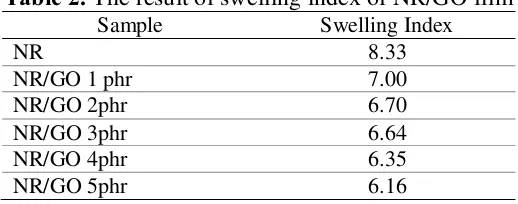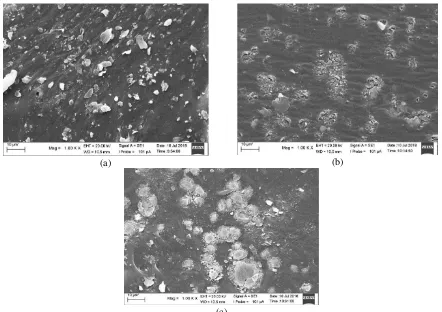Journal of Physics: Conference Series
PAPER • OPEN ACCESS
The study on physical and mechanical properties of latex/graphene
oxide composite film
To cite this article: S Gea et al 2018 J. Phys.: Conf. Ser. 1120 012052
View the article online for updates and enhancements.
The 8th International Conference on Theoretical and Applied Physics IOP Conf. Series: Journal of Physics: Conf. Series1120 (2018) 012052
IOP Publishing doi:10.1088/1742-6596/1120/1/012052
The study on physical and mechanical properties of latex/
graphene oxide composite film
S Gea1*, D A Barus2, Y S Sibarani 2, N Panindia1, J N Sari1, K Sebayang2, H Ginting2 and Y A Hutapea1
1Department of Chemistry, Faculty of Mathematic and Natural Sciences, University
of Sumatera Utara, Jl. Bioteknologi No. 1 Medan 20155
2Department of Physics, Faculty of Mathematic and Natural Sciences, University of
Sumatera Utara, Jl. Bioteknologi No. 1 Medan 20155
Corresponding author: [email protected]
Abstract. This study examined the effects of the addition of Graphene Oxide (GO) to the physical and mechanical properties of latex. GO was synthesized from the graphite of the pencil rod using the modified Hummer method. The composite was made by using stirrer and printed with casting method. Several tests were conducted in order to examine the properties. The swelling index was performed to examine the physical properties, tensile strength test to test the mechanical properties seen by tensile test, and lastly Scanning Electron Microscopy (SEM) to identify the morphology. The results show that the swelling index value changed with the addition of GO to the latex. The mechanical properties were increasing with optimum value of tensile strength with the quantity of GO as much as 4 phr, ie 3.72 MPa. Moreover, the morphology indicates the interaction that occurs between curative materials with the GO, causing the surface tighter and denser. It leads to the increasing of the tensile strength.
1. Introduction
Recently, natural rubber has begun to become the center of attention in the industrial world. This is due to the increasing number of consumer demand for goods from rubber raw materials. Industries that will absorb rubber marketing are the tire industry, automotive, asphalt, and others. Natural rubber has low physical properties when compared to those that have been given additional ingredients such as fillers. Therefore, it is necessary to add certain ingredients that can improve the characteristics so that this natural rubber can be produced into more useful products. Filling materials are added to natural rubber latex formulations to improve the physical properties of natural rubber latex so that high and can be used for the production of latex raw materials.
Fillers added to natural rubber latex can increase vulcanization of natural rubber so that its tensile strength and other mechanical properties will be increased [1]. Each type of filling material provides certain properties as a result of its specific chemical surface. The filler material with nanoparticle size is able to increase the value of polymer reinforcement compared to a large filler material [2]. Carbon black, silica, clays, boehmite, carbon nanotubes and etc., have been utilized as reinforcing fillers in the rubber industry.
hexagonal-The 8th International Conference on hexagonal-Theoretical and Applied Physics IOP Conf. Series: Journal of Physics: Conf. Series1120 (2018) 012052
IOP Publishing doi:10.1088/1742-6596/1120/1/012052
2
interesting characteristics of graphene is its highly ordered and almost perfect arrangement of atoms. Graphene can be used as a filler in composite materials and more favored than other fillers, due to high surface area, aspect ratio, tensile strength, electrical and thermal conductivity, flexibility, ability to resist electromagnetic waves, transparency, and low thermal expansion coefficient [4].
But in the synthesis process, graphene requires a high cost. As one of the derivatives, graphene oxide can be an alternative [5]. Graphene oxide or commonly called graphite oxide or graphitic acid, is a compound of a mixture of carbon, hydrogen, and oxygen obtained through a strong oxidation process of graphite having a layered structure such as graphite, just the position of carbon atoms in graphene oxide plus the presence of groups of oxygen atoms which not only extends the distance between layers but also makes the atomic layer thick and hydrophilic. As a result, oxidation of this layer can interact with water under ultrasonification treatment [3,6].
2. Materials and Method
2.1. Materials
Graphite flakes were obtained from pencil rod 5B. Natural rubber (NR) latex with a total solid content of 60%. The ingredients including sulfur (S), zinc oxide (ZnO), Pottasium hydroxide (KOH) and TMTD (Tetramethylthiuram disulfide). The reagent including concentrated sulfuric acid (H2SO4), potassium permanganate (KMnO4), Sodium nitrate (NaNO3), hydrogen peroxide (H2O2) were purchased from Merck.
2.2. Synthesis process of graphene oxide (GO)
Graphite oxide was synthesized from pencil rod 5B flakes according to a modified Hummers’ method. Briefly, as many as 2 g of pencil rod 5B flakes were added to 1 g of NaNO3 and 46 mL of H2SO4 and they were mixtured by stirring process. Then, an amount of 6 g KMnO4 was added slowly. The system was kept in the ice-bath to keep the temperature low at 20 oC. Next, the mixture was heated at 35 oC for 20 hours, and slowly added with 92 mL distilled water and stirred for 15 minutes. After that, the mixture were added with H2O2 30% to reduce KMnO4 which losing the vapors and bubbles. The mixture was neutralized using the sentrifugation at 7200 rpm in 10 minutes until its pH was 7, then it was treated by ultrasonicator at 50/60 Hz for 30 minutes. Finally, the GO powder was dried in oven at a temperature of 105 oC.
2.3. Preparation of NR/GO composite
The GO powder was dispersed in distilled water at 2mg/mL for 4 h and putted in ultrasonicator to produce a homogeneous suspension. Then, it was mixed with the natural rubber and the curative agent with stiring with magnetic stirrer for 2 h. The mixture was casted to plates glass and maturated for overnight at room temperature. Then, it was dried overnight at 70 oC, and continued by heating them at 100 oC for 15 mins for further drying to solve the cross-linking process. The formulation of the mixture was exhibited on the table below.
Table 1. The formulation of the mixture
The 8th International Conference on Theoretical and Applied Physics IOP Conf. Series: Journal of Physics: Conf. Series1120 (2018) 012052
IOP Publishing doi:10.1088/1742-6596/1120/1/012052
2.4. Characterization
The film morphology was characterized using scanning electron microscope (SEM) (ZEISS). The film mechanical properties were conducted on a universal testing machine (RTF-1500) at room temperature with cross-head speed of 500 mm/min. The samples were prepared by cutting of 40 mm long and 10 mm wide whereas the thickness was measured each other. The distance between the jaws was 20 mm. The swelling test was carried out according to ASTM D 3616. The test pieces weight about 0.2 g. The sample was soaked in toluene for 24 hours.
3. Result and Discussion
3.1. Swelling index of NR/GO film
The Result of swelling index was shown in Table 2. The addition of grapheme oxide as a filler in NR latex films has decreased the value of swelling index. Without addition the swelling index is 8.33 and it was changed with addition GO. From the result, the film has moderately vulcanized state.
Table 2. The result of swelling index of NR/GO film
Sample Swelling Index
The 8th International Conference on Theoretical and Applied Physics IOP Conf. Series: Journal of Physics: Conf. Series1120 (2018) 012052
IOP Publishing doi:10.1088/1742-6596/1120/1/012052
4
(a) (b)
(c)
Figure 1. SEM images of (a) Latex film ; (b) latex/graphene oxide film with 1 phr ; (c) latex/graphene oxide film with 4 phr.
3.3. Tensile properties
The stress-strain curves of natural rubber and latex/graphene oxide film was given in Fig. 2. This figure showed significant improvement on tensile strength of latex and latex/GO films. With the addition of filler at latex from 1 phr variation can increase tensile strength of latex from 1.17 MPa to 2.77 MPa. This continued to increase to a maximum of 4 phr up to 255% and decreases with the addition of 5 phr. It is shown in Table 2. This sharp increase in stress was caused by strain-induced crystallization during the rapid stretching phase [7].
From the previous study, Chunmei et al. (2017) [7], obtained an increased tensile strength with the addition of 5% graphene oxide. Malas et al. (2012) [8], revealed a strong increase in Pull value with the addition of 3% graphite. From these results, it appears that GO has a stronger reinforcement effect on the increase in tensile strength of latex.
4. Conclusion
Graphene oxide as a reinforce agent for latex was prepared by mixing and casting method. The tensile strength was proven to be increased with the addition GO. The swelling index is also changed. Moreover, the morphology analysis revealed the interaction between GO and the curative agent in latex.
5. Acknowledgement
Authors would like to acknowledge Rector of University of Sumatera Utara for providing the research
The 8th International Conference on Theoretical and Applied Physics IOP Conf. Series: Journal of Physics: Conf. Series1120 (2018) 012052
IOP Publishing doi:10.1088/1742-6596/1120/1/012052
6. References
[1] William J H 2008 J. Waste Manag. 29(4) 797 [2] Leblanc J L 2002 Prog. Polym. Sci.27 627
[3] Novoselov K S, Geim A K, Morozov S V, Jiang D, Zhang Y, Dubonos S V, Grigorevia I V and Firsov A A 2004 Science 306(5696) 666
[4] Dreyer D R, Park S, Bielawski C W and Ruoff R S Chem. Soc. Rev. 39 228
[5] Amaturrahim S A, Gea S, Nasution D Y and Hutapea Y A 2018 Asian J. Chem30(7) 1564 [6] Gea S, Sari J N, Bulan R, Piliang A, Amaturrahim S A, Hutapea Y A 2018 Journal of Physics:
Conf. Series 970 012006

